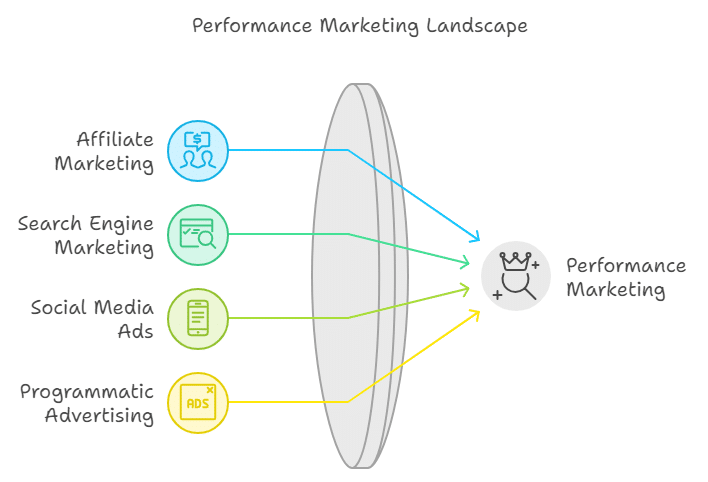In today’s data-driven world, performance marketing stands out as one of the most efficient advertising strategies.
It offers a clear path to understanding where your marketing dollars are going and ensures that you only pay for measurable actions like clicks, conversions, or purchases.
But how exactly does it work, and why is it so effective?
In this post, we’ll see what is performance marketing, its inner workings, and how it drives results in the context of digital advertising.
Let’s get started…
What Is Performance Marketing?
Performance marketing is a digital advertising strategy where advertisers pay only for specific actions—such as when a user clicks, fills out a form, or makes a purchase. This model focuses entirely on measurable results, making it a cost-effective and scalable method for businesses of all sizes.
Key Features of Performance Marketing:
- Pay for Results: Unlike traditional advertising, where you pay upfront, performance marketing ties your spending directly to outcomes.
- Data-Driven: It leverages analytics to continuously monitor and optimize campaigns.
- Scalable: You can adjust your budget, target audience, and strategy based on real-time performance data.
By focusing on tangible outcomes, performance marketing provides transparency in ad spend and helps businesses make smarter investment decisions.
How Does Performance Marketing Work?
Performance marketing operates across various channels, all aiming to drive specific user actions. Here’s how it breaks down across popular platforms:

- Affiliate Marketing: Partners promote your product or service, earning a commission for every sale or lead generated. They only get paid when they deliver.
- Search Engine Marketing (SEM): Brands bid on specific keywords to appear at the top of search engine results. Advertisers pay only when someone clicks on their ad.
- Social Media Ads: Platforms like Facebook and Instagram offer targeted ads based on user demographics and behaviors. You pay per click, view, or conversion.
- Programmatic Advertising: An automated process where algorithms place ads in real-time on relevant websites. This ensures optimal audience targeting and cost efficiency.
These channels work in tandem, providing brands with multiple touchpoints to engage and convert their audiences.
What Are the Stages of the Performance Marketing Funnel?
The performance marketing funnel mirrors the customer journey, breaking it down into stages that marketers can optimize:
- Awareness: Your ads first introduce your brand to potential customers.
- Interest: Engaging content piques their curiosity, encouraging them to explore further.
- Desire: The audience begins considering your product, comparing it to alternatives.
- Action: The user takes the desired action, such as purchasing or signing up for a service.
Each stage of the funnel can be tracked and optimized to improve conversion rates, making performance marketing a highly targeted approach.
What Metrics Matter in Performance Marketing?
Performance marketing is all about metrics. If you can measure it, you can improve it. Here are the key metrics to monitor:
- Cost Per Acquisition (CPA): The amount spent to acquire one customer.
- Click-Through Rate (CTR): The percentage of people who click on your ad after seeing it.
- Return on Ad Spend (ROAS): The revenue generated for every dollar spent on advertising.
- Conversion Rate: The percentage of users who complete a desired action, such as making a purchase.
These metrics allow you to fine-tune campaigns in real time, ensuring every dollar spent is maximized.
What Are the Benefits of Performance Marketing?
Cost Efficiency
One of the primary advantages of performance marketing is its cost efficiency. Since you’re only paying for successful actions—like clicks, conversions, or sales—you’re maximizing your return on investment (ROI). It eliminates the waste often associated with traditional advertising methods, allowing you to focus on channels that perform.
Enhanced Targeting
With performance marketing, precision is key. You can target specific audiences based on behaviors, demographics, and interests, ensuring that your ads reach the right people at the right time. Whether it’s Facebook Pixel tracking or using Google’s advanced targeting options, the data you collect allows for hyper-focused campaigns.
Real-Time Optimization
Unlike traditional campaigns that take time to analyze and adjust, performance marketing offers the flexibility to make changes instantly. If a campaign isn’t performing well, you can tweak your messaging, targeting, or even pause it without wasting further budget.
Measurable Outcomes
Every dollar spent in performance marketing is trackable. You know where your money is going, and you can identify which campaigns are yielding the best returns. This level of transparency helps marketers make informed decisions and plan for future campaigns.
How Do Connected TV (CTV) and OTT Advertising Fit Into Performance Marketing?
As consumers shift away from traditional cable TV, brands are tapping into Connected TV (CTV) and Over-The-Top (OTT) platforms to reach their target audiences. Both CTV and OTT offer the perfect blend of traditional TV’s reach with digital advertising’s precise targeting.
What Is Connected TV (CTV) Advertising?
CTV refers to ads delivered through internet-connected devices like smart TVs, Roku, or Apple TV. Unlike traditional TV ads, CTV ads allow marketers to target specific audience segments based on viewing habits, making it an effective performance marketing tool.
What Is Over-The-Top (OTT) Advertising?
OTT is similar to CTV but refers specifically to video content delivered via streaming services like Netflix, Hulu, or Amazon Prime. OTT advertising allows you to target viewers based on their content preferences, ensuring your ads are more relevant and engaging.
Why Are CTV and OTT Advertising Effective for Performance Marketing?
- Targeted Reach: Both CTV and OTT allow you to serve ads to specific demographics based on their content consumption habits.
- Higher Engagement: Video ads, especially when interactive, are more engaging and lead to higher conversion rates compared to traditional digital ads.
- Measurable Results: You can track user behavior after viewing an ad, giving you insight into what works best.
What Is Programmatic Advertising and How Does It Enhance Performance Marketing?
Programmatic advertising automates the buying and placement of ads, ensuring that your ads are delivered to the most relevant audiences in real-time. This process is driven by algorithms that bid on ad space for you, optimizing for maximum efficiency.
Benefits of Programmatic Advertising:
- Efficiency: Programmatic buying saves time and money by automating the ad placement process.
- Precision Targeting: Algorithms target the right audience at the right time, making ad spending more effective.
- Real-Time Data: You have access to performance data as campaigns run, allowing for instant adjustments to optimize results.
Programmatic advertising enhances performance marketing by combining automation with precise targeting, ensuring that ads are both cost-effective and impactful.
How Can You Succeed in Performance Marketing?
Set Clear Goals
Having defined, measurable goals is the foundation of any successful performance marketing strategy. Whether it’s increasing sales, generating leads, or improving brand awareness, clear objectives keep your campaigns focused and on track.
Use Data Analytics
Data is the cornerstone of performance marketing. By leveraging data analytics, you can gain insights into user behavior, campaign performance, and areas for improvement. This allows for continuous optimization.
Implement A/B Testing
A/B testing lets you compare different versions of an ad or landing page to see which performs better. By constantly testing and refining your approach, you can improve conversion rates and maximize ROI.
Prioritize Quality Content
Content plays a significant role in performance marketing. Whether it’s a blog post, video ad, or landing page, high-quality, engaging content is key to capturing attention and driving action.
Collaborate with Affiliates
Partnering with affiliates can enhance your performance marketing efforts. Affiliates can help expand your reach and drive traffic to your brand, resulting in increased conversions.
Challenges in Performance Marketing
Ad Fatigue
As consumers are exposed to the same ads repeatedly, ad fatigue can set in, leading to decreased engagement. To combat this, regularly refresh ad creatives and messaging.
Data Privacy Concerns
With increasing regulations around data privacy, advertisers must navigate challenges related to user consent and data collection. It’s crucial to remain compliant while still gathering valuable insights.
Measuring Attribution
Attributing conversions to specific touchpoints in the customer journey can be complex. Employ multi-touch attribution models to gain a more comprehensive understanding of performance.
Conclusion: Why Performance Marketing Matters
Performance marketing offers a clear, measurable path to success. By focusing on real-time results, optimizing campaigns based on data, and leveraging innovative channels like CTV, OTT marketing, and programmatic advertising, businesses can achieve significant returns on their marketing investments.
Ultimately, the transparency and accountability that performance marketing provides make it a powerful tool for any business looking to grow in today’s competitive digital landscape.








